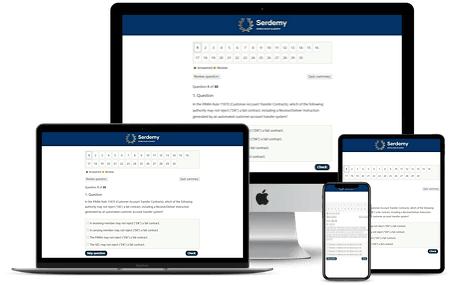Quiz-summary
0 of 30 questions completed
Questions:
- 1
- 2
- 3
- 4
- 5
- 6
- 7
- 8
- 9
- 10
- 11
- 12
- 13
- 14
- 15
- 16
- 17
- 18
- 19
- 20
- 21
- 22
- 23
- 24
- 25
- 26
- 27
- 28
- 29
- 30
Information
Premium Practice Questions
You have already completed the quiz before. Hence you can not start it again.
Quiz is loading...
You must sign in or sign up to start the quiz.
You have to finish following quiz, to start this quiz:
Results
0 of 30 questions answered correctly
Your time:
Time has elapsed
Categories
- Not categorized 0%
- 1
- 2
- 3
- 4
- 5
- 6
- 7
- 8
- 9
- 10
- 11
- 12
- 13
- 14
- 15
- 16
- 17
- 18
- 19
- 20
- 21
- 22
- 23
- 24
- 25
- 26
- 27
- 28
- 29
- 30
- Answered
- Review
-
Question 1 of 30
1. Question
Anika, a Registered Options Principal, is conducting a supervisory review of trading activity in thinly-traded equity options. She identifies a pattern where several seemingly unrelated customer accounts, all approved for Level 3 options trading, consistently place numerous small-lot buy orders for the same out-of-the-money call option series within the last fifteen minutes of the trading day. Her review of the underlying stock’s activity reveals that one of these accounts simultaneously executes a single, large block purchase of the stock at a price significantly above the prevailing market price just moments before the 4:00 PM ET close. Considering these coordinated actions, which of the following represents the most significant regulatory concern Anika must address?
Correct
The trading pattern described indicates a potential instance of market manipulation known as marking the close. This practice involves executing transactions in a security at or near the end of the trading day with the intent to influence the security’s closing price. In this scenario, the coordinated small-lot call option purchases, combined with a large, price-inflating stock trade just before the close, suggest an attempt to create an artificial closing price for the underlying stock. A manipulated closing price can have several improper effects, such as altering the settlement value of derivative contracts, affecting margin calculations for positions held overnight, and deceiving other market participants about the true market value and demand for the security. This activity is a serious violation of antifraud and anti-manipulation provisions, specifically FINRA Rule 2020, which prohibits the use of manipulative, deceptive, or other fraudulent devices, and Section 9(a)(2) of the Securities Exchange Act of 1934, which makes it unlawful to effect a series of transactions creating actual or apparent active trading in a security or raising or depressing the price of such security, for the purpose of inducing the purchase or sale of such security by others. A Registered Options Principal’s supervisory responsibilities under FINRA Rules 3110 and 2360(b)(20) include the detection and prevention of such manipulative schemes.
Incorrect
The trading pattern described indicates a potential instance of market manipulation known as marking the close. This practice involves executing transactions in a security at or near the end of the trading day with the intent to influence the security’s closing price. In this scenario, the coordinated small-lot call option purchases, combined with a large, price-inflating stock trade just before the close, suggest an attempt to create an artificial closing price for the underlying stock. A manipulated closing price can have several improper effects, such as altering the settlement value of derivative contracts, affecting margin calculations for positions held overnight, and deceiving other market participants about the true market value and demand for the security. This activity is a serious violation of antifraud and anti-manipulation provisions, specifically FINRA Rule 2020, which prohibits the use of manipulative, deceptive, or other fraudulent devices, and Section 9(a)(2) of the Securities Exchange Act of 1934, which makes it unlawful to effect a series of transactions creating actual or apparent active trading in a security or raising or depressing the price of such security, for the purpose of inducing the purchase or sale of such security by others. A Registered Options Principal’s supervisory responsibilities under FINRA Rules 3110 and 2360(b)(20) include the detection and prevention of such manipulative schemes.
-
Question 2 of 30
2. Question
Ananya, a Registered Options Principal at a broker-dealer, is performing her daily review of high-risk accounts. She notes that a sophisticated client, Mr. Chen, whose account is approved for portfolio margining, was issued a substantial portfolio margin call for \$40,000 on Monday morning following a sharp, adverse move in his concentrated, uncovered equity call positions. By the close of business on Tuesday, Mr. Chen has not deposited any funds, and the deficiency remains outstanding. Considering the specific requirements of FINRA Rule 4210 for portfolio margin accounts, what is Ananya’s primary supervisory obligation regarding Mr. Chen’s account on Wednesday morning?
Correct
The calculation determines the margin deficiency in the portfolio margin account. The account’s new margin requirement is calculated based on a stress test of the portfolio’s positions. Let’s assume after a significant adverse market move, the new required margin for the account is determined to be \$120,000. The account currently holds equity of \$80,000. The margin deficiency is the difference between the new requirement and the existing equity. Margin Deficiency = New Margin Requirement – Existing Account Equity \[\$120,000 – \$80,000 = \$40,000\] A margin call for \$40,000 is issued. Under the specific regulations governing portfolio margin accounts, as outlined in FINRA Rule 4210(g), the handling of margin deficiencies is much stricter than for standard Regulation T margin accounts. When a firm issues a portfolio margin call, the client has until the end of the next business day (T+1) to meet the call. If the client fails to deposit the required funds by this deadline, the firm is mandated to begin liquidating positions on the following business day (T+2). The firm must liquidate positions sufficient to meet the entire margin deficiency. The Registered Options Principal has a critical supervisory responsibility to ensure that this liquidation procedure is executed without delay. Unlike standard margin calls where extensions may sometimes be granted, the rules for portfolio margin are rigid to mitigate the heightened risks associated with these accounts. The principal cannot grant discretionary extensions or approve alternative actions like hedging in lieu of liquidation once the T+1 deadline has passed. The primary duty is to enforce the rule and bring the account back into compliance by liquidating assets. This strict enforcement protects the firm from the potential for catastrophic losses that can arise from the complex, leveraged strategies permitted in portfolio margin accounts.
Incorrect
The calculation determines the margin deficiency in the portfolio margin account. The account’s new margin requirement is calculated based on a stress test of the portfolio’s positions. Let’s assume after a significant adverse market move, the new required margin for the account is determined to be \$120,000. The account currently holds equity of \$80,000. The margin deficiency is the difference between the new requirement and the existing equity. Margin Deficiency = New Margin Requirement – Existing Account Equity \[\$120,000 – \$80,000 = \$40,000\] A margin call for \$40,000 is issued. Under the specific regulations governing portfolio margin accounts, as outlined in FINRA Rule 4210(g), the handling of margin deficiencies is much stricter than for standard Regulation T margin accounts. When a firm issues a portfolio margin call, the client has until the end of the next business day (T+1) to meet the call. If the client fails to deposit the required funds by this deadline, the firm is mandated to begin liquidating positions on the following business day (T+2). The firm must liquidate positions sufficient to meet the entire margin deficiency. The Registered Options Principal has a critical supervisory responsibility to ensure that this liquidation procedure is executed without delay. Unlike standard margin calls where extensions may sometimes be granted, the rules for portfolio margin are rigid to mitigate the heightened risks associated with these accounts. The principal cannot grant discretionary extensions or approve alternative actions like hedging in lieu of liquidation once the T+1 deadline has passed. The primary duty is to enforce the rule and bring the account back into compliance by liquidating assets. This strict enforcement protects the firm from the potential for catastrophic losses that can arise from the complex, leveraged strategies permitted in portfolio margin accounts.
-
Question 3 of 30
3. Question
As a Registered Options Principal at a member firm, you are reviewing the activities of a newly registered representative, Leon. You discover that Leon has created and posted a series of short videos on a public social media platform. The videos enthusiastically promote a covered call writing strategy as a “consistent income generator.” One video features a chart showing 12 consecutive months of hypothetical positive returns from the strategy but fails to mention that the underlying stock’s price could decline significantly, causing a loss on the overall position. The videos do not explicitly mention the firm but direct viewers to a generic account opening link. In evaluating this situation, what is the most critical regulatory failure that requires your immediate attention?
Correct
Step 1: Identify the communication type. The series of public social media posts is made available to any retail investor and is therefore considered retail communication under FINRA Rule 2210. Step 2: Apply the specific standards for options communications. FINRA Rule 2220(d) and Cboe Rule 9.15 impose stringent content standards on options-related retail communications. Step 3: Analyze the content against the rules. The communication describes a strategy as “low-risk,” includes a hypothetical performance chart suggesting consistent gains, and omits a full explanation of the maximum potential loss. FINRA Rule 2220(d)(1) explicitly prohibits communications from containing any projected or forecast performance figures. Furthermore, Rule 2220(d)(2) requires that communications be balanced and provide a sound basis for evaluation, which includes a prominent explanation of the special risks applicable to options trading. Step 4: Determine the primary regulatory failure. The combination of using prohibited performance projections and presenting an unbalanced, misleading picture of the strategy’s risks by downplaying potential losses constitutes the most significant and fundamental violation. This failure in content substance supersedes procedural errors. All options-related retail communications are subject to the stringent content standards outlined in FINRA Rule 2220 and Cboe Rule 9.15. A core tenet of these rules is the prevention of misleading statements and the assurance of a fair and balanced presentation. Communications must not suggest the likelihood of profit without also explaining the corresponding risk of loss. The use of performance projections, forecasts, or any hypothetical illustration of performance that suggests a specific rate of return is strictly prohibited in options communications directed to the public. While procedural requirements, such as the pre-approval of retail communications by a Registered Options Principal before use, are mandatory, the substantive content of the communication is of paramount importance. A principal’s primary duty in supervision is to ensure that the information disseminated to the public is not false, exaggerated, or misleading. Describing a strategy involving uncovered options or spreads without a thorough and prominent discussion of the significant risks, including the potential for substantial or unlimited loss, fails to provide a sound basis for an investor to evaluate the strategy and is a serious breach of regulatory standards.
Incorrect
Step 1: Identify the communication type. The series of public social media posts is made available to any retail investor and is therefore considered retail communication under FINRA Rule 2210. Step 2: Apply the specific standards for options communications. FINRA Rule 2220(d) and Cboe Rule 9.15 impose stringent content standards on options-related retail communications. Step 3: Analyze the content against the rules. The communication describes a strategy as “low-risk,” includes a hypothetical performance chart suggesting consistent gains, and omits a full explanation of the maximum potential loss. FINRA Rule 2220(d)(1) explicitly prohibits communications from containing any projected or forecast performance figures. Furthermore, Rule 2220(d)(2) requires that communications be balanced and provide a sound basis for evaluation, which includes a prominent explanation of the special risks applicable to options trading. Step 4: Determine the primary regulatory failure. The combination of using prohibited performance projections and presenting an unbalanced, misleading picture of the strategy’s risks by downplaying potential losses constitutes the most significant and fundamental violation. This failure in content substance supersedes procedural errors. All options-related retail communications are subject to the stringent content standards outlined in FINRA Rule 2220 and Cboe Rule 9.15. A core tenet of these rules is the prevention of misleading statements and the assurance of a fair and balanced presentation. Communications must not suggest the likelihood of profit without also explaining the corresponding risk of loss. The use of performance projections, forecasts, or any hypothetical illustration of performance that suggests a specific rate of return is strictly prohibited in options communications directed to the public. While procedural requirements, such as the pre-approval of retail communications by a Registered Options Principal before use, are mandatory, the substantive content of the communication is of paramount importance. A principal’s primary duty in supervision is to ensure that the information disseminated to the public is not false, exaggerated, or misleading. Describing a strategy involving uncovered options or spreads without a thorough and prominent discussion of the significant risks, including the potential for substantial or unlimited loss, fails to provide a sound basis for an investor to evaluate the strategy and is a serious breach of regulatory standards.
-
Question 4 of 30
4. Question
Alistair Finch, the trustee for the Finch Family Heritage Trust, submits a new account application to your firm. The application requests the highest level of options approval to allow for the writing of uncovered calls, with the stated objective of “aggressive income generation.” As the Registered Options Principal reviewing the application package, which of the following actions represents the most critical and foundational step you must take to meet your supervisory obligations under applicable FINRA and Cboe rules?
Correct
When a Registered Options Principal (ROP) reviews a new account application for a fiduciary entity like a trust, the primary and most critical step is to examine the governing legal document, which in this case is the trust agreement. This review is essential to determine the scope of the trustee’s investment powers. FINRA Rules 2090 (Know Your Customer) and 2111 (Suitability) require the firm to understand the customer’s financial status, investment objectives, and risk tolerance. For a trust account, the “customer” is the trust itself, and its objectives and limitations are legally defined by the trust document, not merely by the wishes of the current trustee. The proposed strategy of writing uncovered calls is considered highly speculative and carries unlimited risk, which may be in direct conflict with the trustee’s fiduciary duty to preserve capital and act in the best interests of the beneficiaries. Therefore, before considering the financial resources of the trust or providing the necessary risk disclosures, the ROP must first establish that the trust agreement explicitly grants the trustee the authority to engage in such speculative options strategies. If the document is silent on the matter or contains language restricting investments to prudent or conservative strategies, the ROP must reject the request for this level of options trading, regardless of the trust’s net worth or the trustee’s signature on disclosure forms. Fulfilling other requirements, such as AML checks or providing the Options Disclosure Document, is mandatory but secondary to confirming the fundamental legal authority for the proposed activity.
Incorrect
When a Registered Options Principal (ROP) reviews a new account application for a fiduciary entity like a trust, the primary and most critical step is to examine the governing legal document, which in this case is the trust agreement. This review is essential to determine the scope of the trustee’s investment powers. FINRA Rules 2090 (Know Your Customer) and 2111 (Suitability) require the firm to understand the customer’s financial status, investment objectives, and risk tolerance. For a trust account, the “customer” is the trust itself, and its objectives and limitations are legally defined by the trust document, not merely by the wishes of the current trustee. The proposed strategy of writing uncovered calls is considered highly speculative and carries unlimited risk, which may be in direct conflict with the trustee’s fiduciary duty to preserve capital and act in the best interests of the beneficiaries. Therefore, before considering the financial resources of the trust or providing the necessary risk disclosures, the ROP must first establish that the trust agreement explicitly grants the trustee the authority to engage in such speculative options strategies. If the document is silent on the matter or contains language restricting investments to prudent or conservative strategies, the ROP must reject the request for this level of options trading, regardless of the trust’s net worth or the trustee’s signature on disclosure forms. Fulfilling other requirements, such as AML checks or providing the Options Disclosure Document, is mandatory but secondary to confirming the fundamental legal authority for the proposed activity.
-
Question 5 of 30
5. Question
The following case is presented to a Registered Options Principal (ROP) for review. An application is submitted to open an account for the “Lin Family Testamentary Trust.” The trustee, a certified public accountant with extensive personal trading experience, seeks the highest level of options approval, including the ability to write uncovered index options. The trust document grants the trustee “full and absolute discretion to invest trust assets as they see fit.” The sole beneficiary is the decedent’s 85-year-old surviving spouse, who has limited financial knowledge and relies on the trust for all living expenses. The trust’s stated investment objective is “preservation of capital and income generation.” Which of the following represents the most critical regulatory obstacle the ROP must resolve before considering approval for writing uncovered options?
Correct
The core issue revolves around the intersection of a trustee’s fiduciary duty and a broker-dealer’s suitability obligations under FINRA and Cboe rules. For a trust account, the suitability analysis, governed by FINRA Rule 2111, must focus on the beneficiary’s financial situation and needs, as well as the stated objectives of the trust itself, not solely on the sophistication or risk tolerance of the trustee. In this case, the beneficiary is a minor, and the trust’s purpose is to fund future educational needs, which implies a long-term investment horizon and a need for capital preservation and growth, rather than speculative, high-risk strategies. Writing uncovered calls is one of the riskiest options strategies, exposing the trust to unlimited potential losses. While the trustee may be experienced, their desire to pursue an “aggressive growth” strategy through uncovered calls is fundamentally at odds with the fiduciary responsibility to protect and grow assets for a minor’s education. A Registered Options Principal’s primary duty, as outlined in rules like FINRA 2360(b)(16) and Cboe Rule 9.1, is to conduct diligent inquiry to ensure that such high-risk strategies are appropriate for the account. The silence of the trust document on this specific strategy further complicates approval, but the overriding concern is the suitability for the beneficiary. The principal must conclude that the risk profile of writing uncovered calls is inconsistent with the financial objectives and circumstances of the trust beneficiary, regardless of the trustee’s personal qualifications or the broad powers granted in the trust document.
Incorrect
The core issue revolves around the intersection of a trustee’s fiduciary duty and a broker-dealer’s suitability obligations under FINRA and Cboe rules. For a trust account, the suitability analysis, governed by FINRA Rule 2111, must focus on the beneficiary’s financial situation and needs, as well as the stated objectives of the trust itself, not solely on the sophistication or risk tolerance of the trustee. In this case, the beneficiary is a minor, and the trust’s purpose is to fund future educational needs, which implies a long-term investment horizon and a need for capital preservation and growth, rather than speculative, high-risk strategies. Writing uncovered calls is one of the riskiest options strategies, exposing the trust to unlimited potential losses. While the trustee may be experienced, their desire to pursue an “aggressive growth” strategy through uncovered calls is fundamentally at odds with the fiduciary responsibility to protect and grow assets for a minor’s education. A Registered Options Principal’s primary duty, as outlined in rules like FINRA 2360(b)(16) and Cboe Rule 9.1, is to conduct diligent inquiry to ensure that such high-risk strategies are appropriate for the account. The silence of the trust document on this specific strategy further complicates approval, but the overriding concern is the suitability for the beneficiary. The principal must conclude that the risk profile of writing uncovered calls is inconsistent with the financial objectives and circumstances of the trust beneficiary, regardless of the trustee’s personal qualifications or the broad powers granted in the trust document.
-
Question 6 of 30
6. Question
An evaluation of a customer complaint regarding an option exercise assignment at Apex Securities requires the Registered Options Principal, Priya, to assess the firm’s procedures. The firm’s disclosed policy is an automated, random allocation method. A customer, Mr. Chen, holding a short call position, was assigned an exercise notice and complains that another customer with an identical short position, established later, was not assigned. In her supervisory capacity under Cboe and FINRA rules, which of the following represents the most critical determination for Priya to make regarding the firm’s compliance?
Correct
The primary regulatory requirement for a member firm regarding the allocation of option exercise assignment notices, as stipulated by Cboe Rule 6.21, is the establishment and consistent application of a fixed, fair, and equitable procedure. Firms are permitted to use various methods, such as a random allocation, a first-in, first-out (FIFO) basis, or any other procedure that is deemed fair. The critical element for compliance is not the specific method chosen but rather that the firm has this method detailed in its written supervisory procedures and applies it consistently and impartially to all applicable customer accounts. A customer’s preference for one method over another, such as believing FIFO is inherently fairer than a random allocation, does not invalidate the firm’s compliant procedure. The Registered Options Principal’s supervisory responsibility in reviewing a complaint about an assignment is to verify that the firm’s established and disclosed procedure was followed precisely for the specific event in question. This involves confirming that an automated system ran as intended or that a manual process was conducted without bias or deviation from the written plan. Any manual intervention or selective application that deviates from the disclosed method would be a serious violation, as it would compromise the fairness and integrity of the allocation process.
Incorrect
The primary regulatory requirement for a member firm regarding the allocation of option exercise assignment notices, as stipulated by Cboe Rule 6.21, is the establishment and consistent application of a fixed, fair, and equitable procedure. Firms are permitted to use various methods, such as a random allocation, a first-in, first-out (FIFO) basis, or any other procedure that is deemed fair. The critical element for compliance is not the specific method chosen but rather that the firm has this method detailed in its written supervisory procedures and applies it consistently and impartially to all applicable customer accounts. A customer’s preference for one method over another, such as believing FIFO is inherently fairer than a random allocation, does not invalidate the firm’s compliant procedure. The Registered Options Principal’s supervisory responsibility in reviewing a complaint about an assignment is to verify that the firm’s established and disclosed procedure was followed precisely for the specific event in question. This involves confirming that an automated system ran as intended or that a manual process was conducted without bias or deviation from the written plan. Any manual intervention or selective application that deviates from the disclosed method would be a serious violation, as it would compromise the fairness and integrity of the allocation process.
-
Question 7 of 30
7. Question
A Registered Options Principal (ROP) at a broker-dealer is overseeing the firm’s relationship with a new institutional client, Apex Quantitative Fund. Apex has been approved for portfolio margining and is implementing a high-volume strategy that involves writing a significant number of deep out-of-the-money uncovered puts on a volatile broad-based index. The ROP notes that while the positions currently meet the standard portfolio margin requirements under FINRA Rule 4210(g), the strategy’s risk profile is heavily concentrated in tail-risk events. Considering the firm’s obligations under various SRO rules and federal securities laws, which of the following supervisory actions is most critical for the ROP to undertake in this situation?
Correct
The most critical supervisory action is to ensure the firm’s risk management controls, mandated by SEA Rule 15c3-5, are specifically calibrated to address the unique tail risk presented by the client’s strategy, which may necessitate stress tests beyond the standard parameters required for portfolio margining. While FINRA Rule 4210(g) outlines the standard requirements for portfolio margin, including the use of a theoretical intermarket margin system (TIMS) and standardized stress test scenarios, a principal’s supervisory duty extends further, especially when dealing with sophisticated institutional clients and potentially high-risk strategies. The core issue is that a strategy heavily concentrated in far out-of-the-money short options might present extreme, non-linear risk (tail risk) that is not fully captured by the standardized ten valuation points in the portfolio margin grid. SEA Rule 15c3-5 requires firms that provide market access to have robust risk management controls to prevent the entry of erroneous orders or orders that exceed pre-set credit or capital thresholds. This includes controls over the firm’s own risk exposure. Therefore, the ROP must go beyond simply verifying compliance with the base portfolio margin rules. The ROP must actively assess whether the firm’s risk models and supervisory control systems, as required by FINRA Rule 3120, are adequate for the specific risk profile of this client. This involves evaluating if custom stress scenarios, more severe than the standard ones, are needed to properly model the potential losses and if the firm’s capital and credit controls are sufficient to handle a worst-case scenario stemming from this specific strategy.
Incorrect
The most critical supervisory action is to ensure the firm’s risk management controls, mandated by SEA Rule 15c3-5, are specifically calibrated to address the unique tail risk presented by the client’s strategy, which may necessitate stress tests beyond the standard parameters required for portfolio margining. While FINRA Rule 4210(g) outlines the standard requirements for portfolio margin, including the use of a theoretical intermarket margin system (TIMS) and standardized stress test scenarios, a principal’s supervisory duty extends further, especially when dealing with sophisticated institutional clients and potentially high-risk strategies. The core issue is that a strategy heavily concentrated in far out-of-the-money short options might present extreme, non-linear risk (tail risk) that is not fully captured by the standardized ten valuation points in the portfolio margin grid. SEA Rule 15c3-5 requires firms that provide market access to have robust risk management controls to prevent the entry of erroneous orders or orders that exceed pre-set credit or capital thresholds. This includes controls over the firm’s own risk exposure. Therefore, the ROP must go beyond simply verifying compliance with the base portfolio margin rules. The ROP must actively assess whether the firm’s risk models and supervisory control systems, as required by FINRA Rule 3120, are adequate for the specific risk profile of this client. This involves evaluating if custom stress scenarios, more severe than the standard ones, are needed to properly model the potential losses and if the firm’s capital and credit controls are sufficient to handle a worst-case scenario stemming from this specific strategy.
-
Question 8 of 30
8. Question
An assessment of a new retail communication piece at a member firm is being conducted by Amara, the firm’s Registered Options Principal. The communication is a worksheet designed to illustrate the benefits of a long condor spread using puts. The worksheet’s headline reads, “A Four-Legged Strategy to Capture Profits in Any Market Condition,” and the body text repeatedly highlights its utility in “volatile environments.” According to FINRA rules governing options communications, which of the following actions is Amara required to take?
Correct
Step 1: Identify the communication type and applicable regulations. The item described is an options worksheet intended for broad distribution to clients, which classifies it as a retail communication under FINRA Rule 2210. As such, it is subject to the specific requirements of FINRA Rule 2220 (Options Communications) and requires prior approval by a Registered Options Principal (ROP). Step 2: Analyze the content of the communication against regulatory standards. The worksheet promotes a long condor spread, a four-legged, limited-risk, limited-profit strategy. This strategy profits when the underlying security exhibits low volatility and trades within a specific range. The communication misleadingly presents the strategy as a tool for “capturing profits in any market condition” and emphasizes its use in “volatile environments.” This is a direct misrepresentation of the strategy’s mechanics and profit profile. Step 3: Evaluate the ROP’s supervisory obligation. FINRA Rule 2220 mandates that all options communications must be fair and balanced and must not contain any false, exaggerated, or misleading statements. It must provide a sound basis for evaluating the facts regarding any particular security or strategy. The ROP’s primary duty is to ensure compliance with these standards. Step 4: Determine the required corrective action. Because the worksheet contains fundamentally misleading information about the conditions under which the strategy is profitable, it violates the fair and balanced standard. The ROP must reject the communication. The required correction is not merely to add a generic risk disclosure but to fundamentally rewrite the misleading language. The communication must be revised to accurately state that the long condor spread is a low-volatility strategy with limited profit potential and that it incurs the maximum loss if the underlying security is highly volatile and moves significantly outside the range of the strike prices. A Registered Options Principal is responsible for reviewing and approving all retail communications concerning options. This duty, outlined in FINRA Rules 2210 and 2220, is critical for investor protection. The core principle is that all communications must be fair, balanced, and not misleading. For complex strategies like condor spreads, this requirement is particularly stringent. A long condor spread is a neutral strategy that profits from time decay and low volatility, where the underlying price remains stable between the inner strike prices. Suggesting it is suitable for volatile markets is a material misrepresentation. The ROP must ensure that the potential for profit is not exaggerated and that the risks, including the specific market conditions that would lead to a loss, are clearly and prominently disclosed. Simply adding a generic risk warning or ensuring the Options Disclosure Document is available does not cure a communication that is fundamentally misleading about the nature of the strategy itself. The principal’s duty is to reject such a communication and mandate specific revisions that correct the misleading information, ensuring clients receive an accurate and sound basis for evaluating the strategy.
Incorrect
Step 1: Identify the communication type and applicable regulations. The item described is an options worksheet intended for broad distribution to clients, which classifies it as a retail communication under FINRA Rule 2210. As such, it is subject to the specific requirements of FINRA Rule 2220 (Options Communications) and requires prior approval by a Registered Options Principal (ROP). Step 2: Analyze the content of the communication against regulatory standards. The worksheet promotes a long condor spread, a four-legged, limited-risk, limited-profit strategy. This strategy profits when the underlying security exhibits low volatility and trades within a specific range. The communication misleadingly presents the strategy as a tool for “capturing profits in any market condition” and emphasizes its use in “volatile environments.” This is a direct misrepresentation of the strategy’s mechanics and profit profile. Step 3: Evaluate the ROP’s supervisory obligation. FINRA Rule 2220 mandates that all options communications must be fair and balanced and must not contain any false, exaggerated, or misleading statements. It must provide a sound basis for evaluating the facts regarding any particular security or strategy. The ROP’s primary duty is to ensure compliance with these standards. Step 4: Determine the required corrective action. Because the worksheet contains fundamentally misleading information about the conditions under which the strategy is profitable, it violates the fair and balanced standard. The ROP must reject the communication. The required correction is not merely to add a generic risk disclosure but to fundamentally rewrite the misleading language. The communication must be revised to accurately state that the long condor spread is a low-volatility strategy with limited profit potential and that it incurs the maximum loss if the underlying security is highly volatile and moves significantly outside the range of the strike prices. A Registered Options Principal is responsible for reviewing and approving all retail communications concerning options. This duty, outlined in FINRA Rules 2210 and 2220, is critical for investor protection. The core principle is that all communications must be fair, balanced, and not misleading. For complex strategies like condor spreads, this requirement is particularly stringent. A long condor spread is a neutral strategy that profits from time decay and low volatility, where the underlying price remains stable between the inner strike prices. Suggesting it is suitable for volatile markets is a material misrepresentation. The ROP must ensure that the potential for profit is not exaggerated and that the risks, including the specific market conditions that would lead to a loss, are clearly and prominently disclosed. Simply adding a generic risk warning or ensuring the Options Disclosure Document is available does not cure a communication that is fundamentally misleading about the nature of the strategy itself. The principal’s duty is to reject such a communication and mandate specific revisions that correct the misleading information, ensuring clients receive an accurate and sound basis for evaluating the strategy.
-
Question 9 of 30
9. Question
An assessment of a new account application for the “Orion Galactic Trust,” an irrevocable trust, is being conducted by a Registered Options Principal (ROP). The trustee, a sophisticated investor, has applied for the highest level of options trading approval, which includes writing uncovered index puts. The trust document clearly states its primary objectives are “income generation and capital appreciation for the benefit of a local science museum.” The trust holds a substantial, diversified portfolio of blue-chip stocks and has a significant cash balance. The trustee argues that writing cash-secured puts is too conservative and that the premiums from uncovered puts are necessary to meet the income-generation objective for the museum’s benefit. Which of the following is the most critical reason for the ROP to deny the specific request to write uncovered index puts?
Correct
The decision to reject the request for uncovered call writing authority is based on the fundamental conflict between the proposed strategy and the trust’s stated investment objectives. The governing trust document explicitly mandates “preservation of capital and long-term growth” to fund a minor beneficiary’s future education. Writing uncovered calls is a high-risk strategy that exposes the account to theoretically unlimited losses, which is diametrically opposed to the principle of capital preservation. Under FINRA Rule 2111 (Suitability) and the principles of FINRA Rule 2090 (Know Your Customer), the Registered Options Principal (ROP) must evaluate the appropriateness of investment strategies based on the customer’s specific profile. In this scenario, the “customer” is the trust entity, not the trustee. The trustee’s personal investment experience, sophistication, and risk tolerance are irrelevant to the suitability determination for the trust account they manage as a fiduciary. The ROP’s duty is to the trust and its beneficiary. The strategy’s high-risk nature is unsuitable for an account with a long-term growth objective for a minor and an overriding mandate to preserve capital. Therefore, approving this level of trading would be a violation of the firm’s suitability obligations, regardless of any other factors. The ROP must prioritize the trust’s documented objectives over the trustee’s requested strategy.
Incorrect
The decision to reject the request for uncovered call writing authority is based on the fundamental conflict between the proposed strategy and the trust’s stated investment objectives. The governing trust document explicitly mandates “preservation of capital and long-term growth” to fund a minor beneficiary’s future education. Writing uncovered calls is a high-risk strategy that exposes the account to theoretically unlimited losses, which is diametrically opposed to the principle of capital preservation. Under FINRA Rule 2111 (Suitability) and the principles of FINRA Rule 2090 (Know Your Customer), the Registered Options Principal (ROP) must evaluate the appropriateness of investment strategies based on the customer’s specific profile. In this scenario, the “customer” is the trust entity, not the trustee. The trustee’s personal investment experience, sophistication, and risk tolerance are irrelevant to the suitability determination for the trust account they manage as a fiduciary. The ROP’s duty is to the trust and its beneficiary. The strategy’s high-risk nature is unsuitable for an account with a long-term growth objective for a minor and an overriding mandate to preserve capital. Therefore, approving this level of trading would be a violation of the firm’s suitability obligations, regardless of any other factors. The ROP must prioritize the trust’s documented objectives over the trustee’s requested strategy.
-
Question 10 of 30
10. Question
An ROP at a member firm is reviewing a trading surveillance report for a thinly-traded equity option. The report highlights a suspicious pattern of activity originating from several recently opened accounts that were introduced by the same third-party broker. The ROP observes that these accounts are placing small, offsetting limit orders, which is then followed by a large market order from one of the accounts that executes against the others. This sequence repeats, causing a significant spike in the reported trading volume for the option series. Shortly thereafter, an unaffiliated investment newsletter highlights the “unusual options volume” as a bullish signal, which is followed by a surge in buying from the general public. The originating accounts then liquidate their long call positions at a substantial profit. Based on this pattern, which of the following represents the most significant supervisory concern for the ROP?
Correct
The trading activity described constitutes a prohibited manipulative practice known as “painting the tape.” This involves engaging in a series of transactions to create a false or misleading appearance of active trading in a security to induce others to buy or sell it. The core of this violation is the deceptive intent. In this scenario, the coordinated group of accounts places small limit orders to create an illusion of liquidity and a tight market. Then, a large order is executed within the group to generate significant reported volume. This manufactured volume is then used as a catalyst, amplified by a third party, to attract unsuspecting retail investors. As these new investors drive up the option’s price, the original manipulators sell their positions for a profit. This activity is a direct violation of the Securities Exchange Act of 1934, specifically Section 9(a)(2), which prohibits effecting a series of transactions creating actual or apparent active trading for the purpose of inducing the purchase or sale of a security by others. It also violates FINRA Rule 2020, which prohibits the use of manipulative, deceptive, or other fraudulent devices, and FINRA Rule 2010, which requires firms to observe high standards of commercial honor and just and equitable principles of trade. The primary supervisory concern is not merely a technical rule breach, such as a position limit violation, but a fundamental attack on market integrity through deliberate manipulation.
Incorrect
The trading activity described constitutes a prohibited manipulative practice known as “painting the tape.” This involves engaging in a series of transactions to create a false or misleading appearance of active trading in a security to induce others to buy or sell it. The core of this violation is the deceptive intent. In this scenario, the coordinated group of accounts places small limit orders to create an illusion of liquidity and a tight market. Then, a large order is executed within the group to generate significant reported volume. This manufactured volume is then used as a catalyst, amplified by a third party, to attract unsuspecting retail investors. As these new investors drive up the option’s price, the original manipulators sell their positions for a profit. This activity is a direct violation of the Securities Exchange Act of 1934, specifically Section 9(a)(2), which prohibits effecting a series of transactions creating actual or apparent active trading for the purpose of inducing the purchase or sale of a security by others. It also violates FINRA Rule 2020, which prohibits the use of manipulative, deceptive, or other fraudulent devices, and FINRA Rule 2010, which requires firms to observe high standards of commercial honor and just and equitable principles of trade. The primary supervisory concern is not merely a technical rule breach, such as a position limit violation, but a fundamental attack on market integrity through deliberate manipulation.
-
Question 11 of 30
11. Question
The trustee for a newly established family office trust submits an application to open a portfolio margin account. The application indicates the trust’s objective is “capital appreciation with active risk management” and the trustee intends to implement complex, multi-leg options strategies. As the Registered Options Principal responsible for the final approval, what is your most critical initial action after completing the standard Customer Identification Program verification?
Correct
The foundational step in approving an options account for a fiduciary entity, such as a trust, is to verify the legal authority of the individual acting on its behalf. Before any analysis of suitability or delivery of disclosure documents can be meaningfully performed, the Registered Options Principal must confirm that the entity’s governing legal document, in this case, the trust agreement, grants the trustee the specific power to engage in the requested activities. This is a core component of the firm’s due diligence and Know Your Customer obligations under FINRA Rule 2090 and Cboe Rule 9.1. The ROP must scrutinize the trust document to ensure it explicitly permits the trustee to open a securities account, trade options, and, crucially, utilize margin, especially advanced forms like portfolio margin. Without this explicit authorization, the firm would be allowing potentially unauthorized transactions, creating significant legal and regulatory risk. While providing the required risk disclosures, such as the Portfolio Margin Disclosure Statement, and conducting a thorough suitability analysis under FINRA Rule 2111 are mandatory and critical parts of the process, they are logically subsequent to establishing the trustee’s fundamental authority to act. The entire suitability determination is predicated on the trustee having the legal power to implement the strategies being considered.
Incorrect
The foundational step in approving an options account for a fiduciary entity, such as a trust, is to verify the legal authority of the individual acting on its behalf. Before any analysis of suitability or delivery of disclosure documents can be meaningfully performed, the Registered Options Principal must confirm that the entity’s governing legal document, in this case, the trust agreement, grants the trustee the specific power to engage in the requested activities. This is a core component of the firm’s due diligence and Know Your Customer obligations under FINRA Rule 2090 and Cboe Rule 9.1. The ROP must scrutinize the trust document to ensure it explicitly permits the trustee to open a securities account, trade options, and, crucially, utilize margin, especially advanced forms like portfolio margin. Without this explicit authorization, the firm would be allowing potentially unauthorized transactions, creating significant legal and regulatory risk. While providing the required risk disclosures, such as the Portfolio Margin Disclosure Statement, and conducting a thorough suitability analysis under FINRA Rule 2111 are mandatory and critical parts of the process, they are logically subsequent to establishing the trustee’s fundamental authority to act. The entire suitability determination is predicated on the trustee having the legal power to implement the strategies being considered.
-
Question 12 of 30
12. Question
An ROP’s review of trading data at their firm reveals a consistent pattern: the firm’s proprietary options desk, which also facilitates large institutional orders, frequently enters small, aggressive orders in an option series moments before executing a large block order for an institutional client in the same series. The proprietary trades appear to absorb liquidity on one side of the market, which is then followed by the execution of the client’s block trade at a price that is sometimes marginally better than the prevailing quote before the proprietary activity began. The firm’s Written Supervisory Procedures (WSPs) do not specifically address this “market preparation” strategy. Under FINRA and Cboe rules, what is the most appropriate assessment of this situation and the required action by the ROP?
Correct
The core issue is the potential for manipulative activity and a breach of the firm’s duty to its customer. The proprietary trading desk is using non-public information about an imminent, large customer block order to inform its own trading decisions. Even if the stated goal is to “prepare the market” or tighten the spread, this activity constitutes trading ahead of a customer order. This practice violates the fundamental principle of acting in the customer’s best interest and is prohibited under FINRA Rule 2010, which requires adherence to just and equitable principles of trade, and FINRA Rule 2020, which prohibits the use of manipulative or deceptive devices. The firm’s proprietary desk is leveraging its privileged position and knowledge of the customer’s order for its own account, which creates a conflict of interest. The fact that the customer may not be demonstrably harmed, or may even receive a marginally better price, does not legitimize the action. The intent and the act of trading on the basis of this confidential information are the basis of the violation. A Registered Options Principal’s duty under FINRA Rule 3110 (Supervision) and Cboe Rule 9.2 (Supervision of Accounts) is to establish, maintain, and enforce a supervisory system designed to prevent such violations. The absence of a specific policy in the firm’s Written Supervisory Procedures (WSPs) is itself a significant supervisory failure. The ROP must immediately halt the practice, escalate the matter for investigation, and ensure the WSPs are amended to explicitly prohibit this type of activity.
Incorrect
The core issue is the potential for manipulative activity and a breach of the firm’s duty to its customer. The proprietary trading desk is using non-public information about an imminent, large customer block order to inform its own trading decisions. Even if the stated goal is to “prepare the market” or tighten the spread, this activity constitutes trading ahead of a customer order. This practice violates the fundamental principle of acting in the customer’s best interest and is prohibited under FINRA Rule 2010, which requires adherence to just and equitable principles of trade, and FINRA Rule 2020, which prohibits the use of manipulative or deceptive devices. The firm’s proprietary desk is leveraging its privileged position and knowledge of the customer’s order for its own account, which creates a conflict of interest. The fact that the customer may not be demonstrably harmed, or may even receive a marginally better price, does not legitimize the action. The intent and the act of trading on the basis of this confidential information are the basis of the violation. A Registered Options Principal’s duty under FINRA Rule 3110 (Supervision) and Cboe Rule 9.2 (Supervision of Accounts) is to establish, maintain, and enforce a supervisory system designed to prevent such violations. The absence of a specific policy in the firm’s Written Supervisory Procedures (WSPs) is itself a significant supervisory failure. The ROP must immediately halt the practice, escalate the matter for investigation, and ensure the WSPs are amended to explicitly prohibit this type of activity.
-
Question 13 of 30
13. Question
An assessment of a proprietary trader’s activity at your firm reveals a recurring pattern involving options on ZYX Corp., a thinly traded equity. As the Registered Options Principal, your review of the trade blotter shows that on multiple occasions, the trader enters a series of small-lot buy orders for ZYX stock in the final minutes of the trading day, causing a slight uptick in the stock’s closing price. Immediately following this, the trader sells a substantial number of ZYX call options. Which of the following best characterizes the primary regulatory concern this pattern presents?
Correct
This is a conceptual question and does not require a mathematical calculation. The scenario describes a form of market manipulation known as marking the close. Marking the close is a manipulative practice where a trader attempts to influence the closing price of a security by executing purchase or sale orders at or near the end of the trading day. The intent is to create a misleading impression of the security’s value or level of activity, which can benefit other positions held by the trader. In this specific case, the proprietary trader is executing a series of small buy orders in the underlying stock, ZYX Corp., with the sole purpose of artificially inflating its closing price. This artificial inflation directly benefits the trader’s large short call option position, as a higher underlying stock price increases the premium received from selling the calls. This activity is a direct violation of the anti-manipulation provisions of the Securities Exchange Act of 1934, specifically Section 9(a)(2), which makes it unlawful to effect a series of transactions in any security registered on a national securities exchange creating actual or apparent active trading in such security or raising or depressing the price of such security, for the purpose of inducing the purchase or sale of such security by others. A Registered Options Principal has a supervisory duty under FINRA Rule 3110 to establish and maintain a system to supervise the activities of its associated persons that is reasonably designed to achieve compliance with applicable securities laws and regulations, including the prevention of manipulative practices like marking the close.
Incorrect
This is a conceptual question and does not require a mathematical calculation. The scenario describes a form of market manipulation known as marking the close. Marking the close is a manipulative practice where a trader attempts to influence the closing price of a security by executing purchase or sale orders at or near the end of the trading day. The intent is to create a misleading impression of the security’s value or level of activity, which can benefit other positions held by the trader. In this specific case, the proprietary trader is executing a series of small buy orders in the underlying stock, ZYX Corp., with the sole purpose of artificially inflating its closing price. This artificial inflation directly benefits the trader’s large short call option position, as a higher underlying stock price increases the premium received from selling the calls. This activity is a direct violation of the anti-manipulation provisions of the Securities Exchange Act of 1934, specifically Section 9(a)(2), which makes it unlawful to effect a series of transactions in any security registered on a national securities exchange creating actual or apparent active trading in such security or raising or depressing the price of such security, for the purpose of inducing the purchase or sale of such security by others. A Registered Options Principal has a supervisory duty under FINRA Rule 3110 to establish and maintain a system to supervise the activities of its associated persons that is reasonably designed to achieve compliance with applicable securities laws and regulations, including the prevention of manipulative practices like marking the close.
-
Question 14 of 30
14. Question
An assessment of Apex Derivatives Group’s portfolio margining program reveals a need to update its Written Supervisory Procedures (WSPs). As the firm’s Registered Options Principal, you are tasked with ensuring the WSPs fully comply with the specific risk management requirements of FINRA Rule 4210(g). Which of the following represents a mandatory component that must be integrated into these procedures for the firm’s portfolio margin accounts?
Correct
The core of this issue lies in the specific supervisory and risk management obligations a firm must undertake when offering portfolio margining, as mandated by FINRA Rule 4210(g). Unlike standard Regulation T margin, which uses a strategy-based calculation, portfolio margin is a risk-based methodology. It calculates margin requirements for an entire portfolio of instruments based on the potential loss under various hypothetical market scenarios. Because this method can result in lower margin requirements for hedged positions, it necessitates more sophisticated and robust risk management controls by the broker-dealer. FINRA Rule 4210(g) requires that a firm seeking to offer portfolio margining must establish and maintain a comprehensive written risk management policy and supervisory procedures. A critical and mandated component of these procedures is the implementation of stress testing for each portfolio margin account. The firm must define its methodologies for conducting these stress tests, specifying the market conditions and scenarios to be used, such as changes in volatility, interest rates, and the price of the underlying assets. These tests must be performed at established intervals, including at the opening of the account and at least weekly thereafter. The purpose is to identify and manage the risk of concentrated positions and to understand the potential impact of significant market moves on the account’s equity. The firm must also establish specific written credit limits for each customer and have procedures to monitor credit risk exposure. The Registered Options Principal plays a key role in ensuring these procedures are not only established but are also diligently followed.
Incorrect
The core of this issue lies in the specific supervisory and risk management obligations a firm must undertake when offering portfolio margining, as mandated by FINRA Rule 4210(g). Unlike standard Regulation T margin, which uses a strategy-based calculation, portfolio margin is a risk-based methodology. It calculates margin requirements for an entire portfolio of instruments based on the potential loss under various hypothetical market scenarios. Because this method can result in lower margin requirements for hedged positions, it necessitates more sophisticated and robust risk management controls by the broker-dealer. FINRA Rule 4210(g) requires that a firm seeking to offer portfolio margining must establish and maintain a comprehensive written risk management policy and supervisory procedures. A critical and mandated component of these procedures is the implementation of stress testing for each portfolio margin account. The firm must define its methodologies for conducting these stress tests, specifying the market conditions and scenarios to be used, such as changes in volatility, interest rates, and the price of the underlying assets. These tests must be performed at established intervals, including at the opening of the account and at least weekly thereafter. The purpose is to identify and manage the risk of concentrated positions and to understand the potential impact of significant market moves on the account’s equity. The firm must also establish specific written credit limits for each customer and have procedures to monitor credit risk exposure. The Registered Options Principal plays a key role in ensuring these procedures are not only established but are also diligently followed.
-
Question 15 of 30
15. Question
A senior Registered Options Principal (ROP) at a member firm is conducting a supervisory review of a newly opened account for the “Vanguardia Heritage Trust,” a fiduciary account. The junior principal who approved the account noted the trustee’s significant personal wealth and extensive experience with complex options strategies, approving the trust for writing uncovered puts. The ROP’s review of the trust agreement reveals general provisions for “investing in securities for growth and income” but no explicit language authorizing speculative activities, uncovered options, or the use of leverage. Under FINRA and Cboe rules, what is the ROP’s most critical supervisory obligation in this situation?
Correct
The primary supervisory obligation is to verify that the proposed trading strategy is not only suitable for the trust but also explicitly authorized by the trust’s governing legal document. For fiduciary accounts such as trusts, the authority to engage in specific investment activities must be derived from the trust agreement. General provisions for investing in securities are typically insufficient to authorize speculative options strategies like writing uncovered puts, which carry unlimited risk potential. The trustee’s personal financial sophistication and experience are secondary to the constraints and objectives defined within the trust instrument. The Registered Options Principal’s due diligence, under FINRA Rules 2090 (Know Your Customer) and 2111 (Suitability), extends to the legal entity itself. The ROP must ensure the strategy aligns with the trust’s stated objectives, risk tolerance, and the needs of its beneficiaries. Approving an account for speculative strategies without explicit authorization in the trust document would be a significant violation of suitability and supervisory rules. Therefore, the most critical action is to halt any activity and require clarification or amendment of the trust document, or to restrict the account to strategies that are clearly permissible. This supersedes procedural checks like verifying the trustee’s background or ensuring timely document delivery, as the fundamental authority for the trading itself is in question.
Incorrect
The primary supervisory obligation is to verify that the proposed trading strategy is not only suitable for the trust but also explicitly authorized by the trust’s governing legal document. For fiduciary accounts such as trusts, the authority to engage in specific investment activities must be derived from the trust agreement. General provisions for investing in securities are typically insufficient to authorize speculative options strategies like writing uncovered puts, which carry unlimited risk potential. The trustee’s personal financial sophistication and experience are secondary to the constraints and objectives defined within the trust instrument. The Registered Options Principal’s due diligence, under FINRA Rules 2090 (Know Your Customer) and 2111 (Suitability), extends to the legal entity itself. The ROP must ensure the strategy aligns with the trust’s stated objectives, risk tolerance, and the needs of its beneficiaries. Approving an account for speculative strategies without explicit authorization in the trust document would be a significant violation of suitability and supervisory rules. Therefore, the most critical action is to halt any activity and require clarification or amendment of the trust document, or to restrict the account to strategies that are clearly permissible. This supersedes procedural checks like verifying the trustee’s background or ensuring timely document delivery, as the fundamental authority for the trading itself is in question.
-
Question 16 of 30
16. Question
Assessment of a proposed space-sharing agreement reveals that Apex Options Brokers, a FINRA member firm, will be co-locating in an office suite with Nexus Wealth Advisors, an unaffiliated state-registered investment adviser (RIA). Nexus advisors, who are not registered persons of Apex, will occasionally recommend that their advisory clients open accounts at Apex to implement sophisticated options strategies. As the Registered Options Principal (ROP) at Apex, which of the following supervisory procedures is most critical to implement in accordance with FINRA rules governing supervision on a member’s premises?
Correct
A member firm’s supervisory obligations under FINRA Rule 3110 extend to all business conducted on its premises, including situations involving space-sharing arrangements with other financial entities. When a member firm shares physical space with an unaffiliated entity, such as an independent investment adviser (IIA), the paramount regulatory concern is the potential for public confusion. Clients might incorrectly assume the IIA and its personnel are part of, or acting on behalf of, the member firm. This can lead to situations where unregistered individuals appear to be performing functions that require registration, a significant violation. Therefore, the most critical supervisory control an ROP must implement is one that clearly delineates the two firms’ operations. This involves establishing distinct physical separation where possible, using prominent and unambiguous signage to identify each firm, and providing clear written disclosures to any client who is a customer of both entities. These disclosures must clarify the separate nature of the firms and that the IIA’s personnel are not associated with or supervised by the member firm. The objective is to ensure that customers understand precisely which entity is responsible for which services and that the IIA’s employees do not engage in broker-dealer activities on the premises. While monitoring other aspects like compensation or marketing is relevant, preventing the fundamental blurring of lines and the risk of unregistered activity is the primary supervisory duty in this context.
Incorrect
A member firm’s supervisory obligations under FINRA Rule 3110 extend to all business conducted on its premises, including situations involving space-sharing arrangements with other financial entities. When a member firm shares physical space with an unaffiliated entity, such as an independent investment adviser (IIA), the paramount regulatory concern is the potential for public confusion. Clients might incorrectly assume the IIA and its personnel are part of, or acting on behalf of, the member firm. This can lead to situations where unregistered individuals appear to be performing functions that require registration, a significant violation. Therefore, the most critical supervisory control an ROP must implement is one that clearly delineates the two firms’ operations. This involves establishing distinct physical separation where possible, using prominent and unambiguous signage to identify each firm, and providing clear written disclosures to any client who is a customer of both entities. These disclosures must clarify the separate nature of the firms and that the IIA’s personnel are not associated with or supervised by the member firm. The objective is to ensure that customers understand precisely which entity is responsible for which services and that the IIA’s employees do not engage in broker-dealer activities on the premises. While monitoring other aspects like compensation or marketing is relevant, preventing the fundamental blurring of lines and the risk of unregistered activity is the primary supervisory duty in this context.
-
Question 17 of 30
17. Question
As the designated Registered Options Principal (ROP) for a member firm, you are conducting the annual review of the testing procedures for the firm’s proprietary automated supervisory system. This system is designed to flag options recommendations that are inconsistent with a client’s documented investment profile. In evaluating the firm’s compliance with FINRA Rule 3120, which of the following findings from your review would represent the most significant deficiency in the testing of the supervisory control system?
Correct
FINRA Rule 3120 mandates that member firms create and maintain a system of supervisory controls to ensure their supervisory procedures are reasonably designed to achieve compliance with applicable securities laws and regulations. A critical component of this rule is the requirement for the firm to test and verify its supervisory control system at least annually. The goal of this testing is not merely to confirm that a system functions as programmed, but to ensure it is effective in practice at mitigating compliance risks. In the context of an automated suitability review system for options, effective testing must go beyond simple back-testing against historical data. It must assess the system’s resilience against foreseeable risks, including intentional circumvention by employees. A supervisory system that can be easily bypassed by a registered representative who incrementally alters a client’s profile information to meet suitability thresholds for inappropriate strategies is not effective. Therefore, a robust testing protocol must include stress tests and scenarios specifically designed to simulate such manipulative behavior. The absence of such testing represents a significant deficiency in the firm’s annual verification process, as it fails to address a primary risk that the supervisory control system is intended to prevent. This reflects a failure to adequately supervise options account activities as required under FINRA Rule 2360(b)(20).
Incorrect
FINRA Rule 3120 mandates that member firms create and maintain a system of supervisory controls to ensure their supervisory procedures are reasonably designed to achieve compliance with applicable securities laws and regulations. A critical component of this rule is the requirement for the firm to test and verify its supervisory control system at least annually. The goal of this testing is not merely to confirm that a system functions as programmed, but to ensure it is effective in practice at mitigating compliance risks. In the context of an automated suitability review system for options, effective testing must go beyond simple back-testing against historical data. It must assess the system’s resilience against foreseeable risks, including intentional circumvention by employees. A supervisory system that can be easily bypassed by a registered representative who incrementally alters a client’s profile information to meet suitability thresholds for inappropriate strategies is not effective. Therefore, a robust testing protocol must include stress tests and scenarios specifically designed to simulate such manipulative behavior. The absence of such testing represents a significant deficiency in the firm’s annual verification process, as it fails to address a primary risk that the supervisory control system is intended to prevent. This reflects a failure to adequately supervise options account activities as required under FINRA Rule 2360(b)(20).
-
Question 18 of 30
18. Question
An assessment of a sophisticated portfolio margin account held by the Vega Dynamics Fund, a hedge fund client, reveals a unique risk characteristic. The account comfortably meets its current portfolio margin requirement as calculated under the standard stress-test scenarios mandated by FINRA Rule 4210. However, your firm’s internal risk control system, which runs additional, more granular stress tests, flags a high-probability scenario where a +11% move in a single underlying equity, in which the fund has a massive short call concentration, would cause the account’s total equity to fall below the firm’s required minimum equity for portfolio margin accounts. As the Registered Options Principal supervising this account, which course of action is most consistent with your duties?
Correct
The calculation demonstrates the proactive risk assessment required for supervising portfolio margin accounts. Initial Account Equity: $600,000 Firm’s Minimum Equity Requirement for Portfolio Margin: $150,000 Standard Portfolio Margin Requirement (based on largest loss in +/- 15% stress test): $180,000 The account currently has equity of $600,000, which is well above the required $180,000. However, the firm’s enhanced supervisory risk model identifies a high-probability, non-standard scenario (e.g., a +11% move in the underlying security) that would result in a theoretical loss of $460,000. The projected equity after this potential event is calculated as: \[ \text{Projected Equity} = \text{Current Equity} – \text{Theoretical Loss} \] \[ \text{Projected Equity} = \$600,000 – \$460,000 = \$140,000 \] This projected equity of $140,000 is below the firm’s established minimum equity requirement of $150,000 for maintaining a portfolio margin account. A Registered Options Principal’s duty extends beyond simply ensuring the standard margin requirement is met. Under FINRA Rule 4210(g) and Cboe Rule 7.8, firms must have procedures to monitor for and control the risks in portfolio margin accounts, including the risk of concentrated positions. The principal must assess whether the risk presented by the account is appropriate and take action if a potential scenario, even one outside the standard stress test parameters, could cause the account to fall below required equity minimums. The discovery of a plausible scenario that would breach the firm’s minimum equity requirement necessitates supervisory action. This action is not a formal margin call, as no deficit currently exists. Instead, it is a proactive risk management step. The principal must engage with the client to address the potential for this significant loss by either reducing the risk of the position or increasing the capital in the account to better withstand the potential volatility. This supervisory responsibility is a core component of managing the complex risks inherent in portfolio margining.
Incorrect
The calculation demonstrates the proactive risk assessment required for supervising portfolio margin accounts. Initial Account Equity: $600,000 Firm’s Minimum Equity Requirement for Portfolio Margin: $150,000 Standard Portfolio Margin Requirement (based on largest loss in +/- 15% stress test): $180,000 The account currently has equity of $600,000, which is well above the required $180,000. However, the firm’s enhanced supervisory risk model identifies a high-probability, non-standard scenario (e.g., a +11% move in the underlying security) that would result in a theoretical loss of $460,000. The projected equity after this potential event is calculated as: \[ \text{Projected Equity} = \text{Current Equity} – \text{Theoretical Loss} \] \[ \text{Projected Equity} = \$600,000 – \$460,000 = \$140,000 \] This projected equity of $140,000 is below the firm’s established minimum equity requirement of $150,000 for maintaining a portfolio margin account. A Registered Options Principal’s duty extends beyond simply ensuring the standard margin requirement is met. Under FINRA Rule 4210(g) and Cboe Rule 7.8, firms must have procedures to monitor for and control the risks in portfolio margin accounts, including the risk of concentrated positions. The principal must assess whether the risk presented by the account is appropriate and take action if a potential scenario, even one outside the standard stress test parameters, could cause the account to fall below required equity minimums. The discovery of a plausible scenario that would breach the firm’s minimum equity requirement necessitates supervisory action. This action is not a formal margin call, as no deficit currently exists. Instead, it is a proactive risk management step. The principal must engage with the client to address the potential for this significant loss by either reducing the risk of the position or increasing the capital in the account to better withstand the potential volatility. This supervisory responsibility is a core component of managing the complex risks inherent in portfolio margining.
-
Question 19 of 30
19. Question
Assessment of a client’s request to transition to a portfolio margin account requires a Registered Options Principal (ROP) to evaluate several critical factors under FINRA Rule 4210(g). An ROP named Kenji is reviewing such a request from a sophisticated client who uses complex, multi-leg equity option strategies. Which of the following supervisory actions represents the most critical and primary responsibility for Kenji before approving and enabling transactions within this new account structure?
Correct
Under FINRA Rule 4210(g), a member firm must have its portfolio margin methodology and risk management procedures approved by FINRA before it can offer portfolio margining to clients. For a Registered Options Principal supervising the opening of such an account, a critical and mandatory step is ensuring proper risk disclosure. Portfolio margining computes requirements based on the net risk of a customer’s entire portfolio of options, futures, and related securities, which can be significantly more complex than standard Regulation T margin. Due to this complexity and the potential for unique risks, the rules mandate a specific disclosure process. The ROP must ensure the firm provides the customer with the “Portfolio Margining Disclosure Statement” and the “Portfolio Margining Acknowledgment.” The firm is prohibited from accepting any orders for the account to be margined on a portfolio basis until it has received the customer’s signed acknowledgment. This signed document confirms the customer has received the disclosure, understands the risks, and agrees to the terms of portfolio margining. This step is a prerequisite for any trading activity under the portfolio margin program and is a cornerstone of the ROP’s supervisory duty to ensure compliance and customer protection. The ROP must also have a reasonable basis for believing the customer has, and will maintain, a sufficient level of knowledge to understand the risks.
Incorrect
Under FINRA Rule 4210(g), a member firm must have its portfolio margin methodology and risk management procedures approved by FINRA before it can offer portfolio margining to clients. For a Registered Options Principal supervising the opening of such an account, a critical and mandatory step is ensuring proper risk disclosure. Portfolio margining computes requirements based on the net risk of a customer’s entire portfolio of options, futures, and related securities, which can be significantly more complex than standard Regulation T margin. Due to this complexity and the potential for unique risks, the rules mandate a specific disclosure process. The ROP must ensure the firm provides the customer with the “Portfolio Margining Disclosure Statement” and the “Portfolio Margining Acknowledgment.” The firm is prohibited from accepting any orders for the account to be margined on a portfolio basis until it has received the customer’s signed acknowledgment. This signed document confirms the customer has received the disclosure, understands the risks, and agrees to the terms of portfolio margining. This step is a prerequisite for any trading activity under the portfolio margin program and is a cornerstone of the ROP’s supervisory duty to ensure compliance and customer protection. The ROP must also have a reasonable basis for believing the customer has, and will maintain, a sufficient level of knowledge to understand the risks.
-
Question 20 of 30
20. Question
An ROP at Apex Securities is conducting a T+1 review of the prior day’s options trading blotter. The ROP flags a series of transactions executed by a registered representative, Kenji, in the last 15 minutes of trading. The activity involved multiple small-lot buy and sell orders in a thinly traded, out-of-the-money call option on ZYX Corp. These trades were executed at successively higher prices, with the final trade establishing the day’s closing price for that specific option series. The ROP’s review also shows that Kenji’s proprietary account holds a significant long position in the same ZYX call option series. What is the most critical regulatory issue raised by this activity, and what is the appropriate initial supervisory action?
Correct
The scenario describes a pattern of trading activity known as marking the close, which is a prohibited manipulative practice. This activity involves executing a series of trades near the end of the trading day to influence the closing price of a security. Under Section 9(a)(2) of the Securities Exchange Act of 1934 and FINRA Rule 2020, creating a false or misleading appearance of active trading or manipulating the price of a security is a violation. The representative’s actions, executing small-lot trades at incrementally higher prices in a thinly traded option, strongly suggest an attempt to artificially inflate the closing price. The fact that the representative holds a substantial proprietary position in the same option series provides a clear motive for this manipulation, as an artificially high closing price would increase the value of their holdings on paper, potentially improving their account’s equity and margin calculations. A Registered Options Principal’s supervisory responsibilities, as outlined in FINRA Rule 3110 and Cboe Rule 9.2, mandate the detection and investigation of such suspicious activities. The appropriate initial step is to launch an internal investigation into the trading pattern, which includes interviewing the representative about the rationale for the trades and documenting all findings. Depending on the outcome, further escalation, such as reporting to FINRA via a Form U4 amendment or a Rule 4530 filing, may be necessary.
Incorrect
The scenario describes a pattern of trading activity known as marking the close, which is a prohibited manipulative practice. This activity involves executing a series of trades near the end of the trading day to influence the closing price of a security. Under Section 9(a)(2) of the Securities Exchange Act of 1934 and FINRA Rule 2020, creating a false or misleading appearance of active trading or manipulating the price of a security is a violation. The representative’s actions, executing small-lot trades at incrementally higher prices in a thinly traded option, strongly suggest an attempt to artificially inflate the closing price. The fact that the representative holds a substantial proprietary position in the same option series provides a clear motive for this manipulation, as an artificially high closing price would increase the value of their holdings on paper, potentially improving their account’s equity and margin calculations. A Registered Options Principal’s supervisory responsibilities, as outlined in FINRA Rule 3110 and Cboe Rule 9.2, mandate the detection and investigation of such suspicious activities. The appropriate initial step is to launch an internal investigation into the trading pattern, which includes interviewing the representative about the rationale for the trades and documenting all findings. Depending on the outcome, further escalation, such as reporting to FINRA via a Form U4 amendment or a Rule 4530 filing, may be necessary.
-
Question 21 of 30
21. Question
An assessment of the following situation involving a new trust account reveals a critical compliance issue. Mr. Ortiz, the trustee for the Finch Family Irrevocable Trust, opens an options account at your firm. The new account form, trust agreement, and Customer Identification Program verification are all in order. Based on the documents, a Registered Options Principal (ROP) determines the trust is suitable for writing uncovered calls and approves the account. The Options Disclosure Document (ODD) was provided to Mr. Ortiz when he completed the paperwork. Two days later, before the firm has received the signed options agreement back from Mr. Ortiz, he calls his representative and demands that the firm immediately write 10 uncovered call contracts on XYZ stock to take advantage of pre-earnings volatility. Which of the following represents the most direct violation of FINRA rules if the trade is executed as requested?
Correct
The core regulatory issue centers on the sequence of events required for opening an options account and executing the first trade, as mandated by FINRA Rule 2360(b)(16). According to this rule, a Registered Options Principal may approve an account for options trading based on the customer’s background, financial information, and investment objectives. The Options Disclosure Document must be furnished to the customer at or prior to the time the account is approved for options trading. The customer is then required to sign and return the options agreement. The firm must obtain this signed agreement within 15 calendar days of the account’s approval. The most critical part of this rule, and the one applicable in this scenario, dictates what can happen before the signed agreement is received. During the period after approval but before the signed agreement is returned, the account is restricted to closing transactions only. An opening transaction, such as writing a new uncovered call position, is explicitly prohibited until the firm has physically or electronically received the customer’s signed options agreement. The trustee’s urgency or the apparent suitability of the trade does not override this strict procedural requirement. Executing an opening transaction without the signed agreement in hand constitutes a direct violation of FINRA rules, exposing both the representative and the firm to significant regulatory risk.
Incorrect
The core regulatory issue centers on the sequence of events required for opening an options account and executing the first trade, as mandated by FINRA Rule 2360(b)(16). According to this rule, a Registered Options Principal may approve an account for options trading based on the customer’s background, financial information, and investment objectives. The Options Disclosure Document must be furnished to the customer at or prior to the time the account is approved for options trading. The customer is then required to sign and return the options agreement. The firm must obtain this signed agreement within 15 calendar days of the account’s approval. The most critical part of this rule, and the one applicable in this scenario, dictates what can happen before the signed agreement is received. During the period after approval but before the signed agreement is returned, the account is restricted to closing transactions only. An opening transaction, such as writing a new uncovered call position, is explicitly prohibited until the firm has physically or electronically received the customer’s signed options agreement. The trustee’s urgency or the apparent suitability of the trade does not override this strict procedural requirement. Executing an opening transaction without the signed agreement in hand constitutes a direct violation of FINRA rules, exposing both the representative and the firm to significant regulatory risk.
-
Question 22 of 30
22. Question
Kai, a Registered Options Principal at a clearing firm, is conducting a T+1 review of trading activity. An exception report highlights an omnibus account for a small hedge fund that engaged in an unusually high number of transactions in a single, thinly-traded, out-of-the-money index option series expiring at the end of the week. Kai’s analysis reveals dozens of buy and sell orders for 10 to 20 contracts at a time, all executed within a narrow price range. The omnibus account’s net position in the series changed by only five contracts by the end of the day, but its activity constituted over 70% of the total daily volume for that specific contract. What is the most critical regulatory issue that Kai must immediately address?
Correct
The primary regulatory concern is the potential for market manipulation. The trading pattern described, characterized by a high volume of transactions with little to no change in the net position, is a classic red flag for creating a false or misleading appearance of active trading in a security. This practice, often referred to as “painting the tape,” is explicitly prohibited under Section 9(a)(1) of the Securities Exchange Act of 1934. Furthermore, it violates FINRA Rule 2020, which prohibits the use of manipulative, deceptive, or other fraudulent devices, and FINRA Rule 2010, which requires firms to observe high standards of commercial honor and just and equitable principles of trade. The intent behind such activity is often to artificially inflate volume to attract other investors, creating the illusion of liquidity and interest, which can then be exploited. As a Registered Options Principal, the supervisory responsibility under FINRA Rule 3110 includes detecting such manipulative schemes. While other issues like position limits, best execution, and reporting requirements are important supervisory duties, the immediate and most severe concern raised by this specific fact pattern is the potential for a deliberate manipulation of the market, which undermines the integrity of the entire trading process. The principal’s first step should be to investigate this potential manipulation, escalate it to the compliance department, and consider restricting the account’s activity.
Incorrect
The primary regulatory concern is the potential for market manipulation. The trading pattern described, characterized by a high volume of transactions with little to no change in the net position, is a classic red flag for creating a false or misleading appearance of active trading in a security. This practice, often referred to as “painting the tape,” is explicitly prohibited under Section 9(a)(1) of the Securities Exchange Act of 1934. Furthermore, it violates FINRA Rule 2020, which prohibits the use of manipulative, deceptive, or other fraudulent devices, and FINRA Rule 2010, which requires firms to observe high standards of commercial honor and just and equitable principles of trade. The intent behind such activity is often to artificially inflate volume to attract other investors, creating the illusion of liquidity and interest, which can then be exploited. As a Registered Options Principal, the supervisory responsibility under FINRA Rule 3110 includes detecting such manipulative schemes. While other issues like position limits, best execution, and reporting requirements are important supervisory duties, the immediate and most severe concern raised by this specific fact pattern is the potential for a deliberate manipulation of the market, which undermines the integrity of the entire trading process. The principal’s first step should be to investigate this potential manipulation, escalate it to the compliance department, and consider restricting the account’s activity.
-
Question 23 of 30
23. Question
An assessment of a client’s portfolio margin account by a Registered Options Principal (ROP) reveals a significant concentration issue. The account has equity of \(\$5,000,000\) and holds a large position in XYZ stock and its related options, which constitutes 75% of the account’s total risk. The current portfolio margin requirement, calculated by the firm’s approved model, is \(\$4,200,000\). The firm’s written supervisory procedures, established under FINRA Rule 4210(g), mandate an additional “concentration maintenance margin” equal to 50% of the standard PM requirement for any single underlying that exceeds 60% of the portfolio’s risk. Following a significant market event, the firm’s risk model recalculates the standard PM requirement, increasing it by 10%. Based on these facts, what is the new total maintenance margin requirement that the ROP must ensure is applied to this account?
Correct
The calculation to determine the new total maintenance margin requirement is performed in two stages. First, the standard portfolio margin requirement is adjusted for the market event. Second, the firm’s house rule for concentration risk is applied. Initial Standard PM Requirement: \(\$4,200,000\) Market Event Increase: \(10\%\) New Standard PM Requirement = Initial Requirement \(\times\) (1 + Percentage Increase) New Standard PM Requirement = \(\$4,200,000 \times (1 + 0.10) = \$4,620,000\) Next, the concentration maintenance margin must be calculated and added. The firm’s written supervisory procedures (WSPs) require this because the position’s risk (75%) exceeds the firm’s concentration threshold (60%). The add-on is 50% of the new standard PM requirement. Concentration Maintenance Margin Add-on = New Standard PM Requirement \(\times\) 50% Concentration Maintenance Margin Add-on = \(\$4,620,000 \times 0.50 = \$2,310,000\) Finally, the total maintenance margin requirement is the sum of the new standard requirement and the concentration add-on. Total Maintenance Margin Requirement = New Standard PM Requirement + Concentration Add-on Total Maintenance Margin Requirement = \(\$4,620,000 + \$2,310,000 = \$6,930,000\) FINRA Rule 4210(g) governs portfolio margining and requires member firms to establish and maintain a comprehensive risk management system. This system must include written supervisory procedures that define how the firm will monitor and control the risks associated with portfolio margin accounts. A critical component of this is managing concentration risk, where a significant portion of an account’s risk is tied to a single underlying instrument. The rule allows and expects firms to implement house margin requirements that are more stringent than the regulatory minimums to address specific risks like concentration. A Registered Options Principal is responsible for ensuring these WSPs are followed diligently. The supervisory action in this case involves correctly calculating the total margin by first updating the standard requirement based on the risk model’s output after the market event, and then applying the firm-specific concentration charge to that updated figure. The final requirement is the aggregate of the standard and house charges, reflecting a complete risk assessment.
Incorrect
The calculation to determine the new total maintenance margin requirement is performed in two stages. First, the standard portfolio margin requirement is adjusted for the market event. Second, the firm’s house rule for concentration risk is applied. Initial Standard PM Requirement: \(\$4,200,000\) Market Event Increase: \(10\%\) New Standard PM Requirement = Initial Requirement \(\times\) (1 + Percentage Increase) New Standard PM Requirement = \(\$4,200,000 \times (1 + 0.10) = \$4,620,000\) Next, the concentration maintenance margin must be calculated and added. The firm’s written supervisory procedures (WSPs) require this because the position’s risk (75%) exceeds the firm’s concentration threshold (60%). The add-on is 50% of the new standard PM requirement. Concentration Maintenance Margin Add-on = New Standard PM Requirement \(\times\) 50% Concentration Maintenance Margin Add-on = \(\$4,620,000 \times 0.50 = \$2,310,000\) Finally, the total maintenance margin requirement is the sum of the new standard requirement and the concentration add-on. Total Maintenance Margin Requirement = New Standard PM Requirement + Concentration Add-on Total Maintenance Margin Requirement = \(\$4,620,000 + \$2,310,000 = \$6,930,000\) FINRA Rule 4210(g) governs portfolio margining and requires member firms to establish and maintain a comprehensive risk management system. This system must include written supervisory procedures that define how the firm will monitor and control the risks associated with portfolio margin accounts. A critical component of this is managing concentration risk, where a significant portion of an account’s risk is tied to a single underlying instrument. The rule allows and expects firms to implement house margin requirements that are more stringent than the regulatory minimums to address specific risks like concentration. A Registered Options Principal is responsible for ensuring these WSPs are followed diligently. The supervisory action in this case involves correctly calculating the total margin by first updating the standard requirement based on the risk model’s output after the market event, and then applying the firm-specific concentration charge to that updated figure. The final requirement is the aggregate of the standard and house charges, reflecting a complete risk assessment.
-
Question 24 of 30
24. Question
Assessment of a trading pattern at a member firm reveals that Mr. Volkov, a member of the firm’s board of directors, also serves on the board of XYZ Corp, a publicly traded company. Anika, the firm’s Registered Options Principal, notes that a newly established trust account, for which Mr. Volkov is the sole trustee, purchased a substantial quantity of short-term, out-of-the-money XYZ call options. Two days later, XYZ Corp publicly announced it was being acquired at a significant premium, causing the value of the call options to increase dramatically. What is the most critical supervisory concern that Anika must address in this situation?
Correct
The situation presents significant red flags for the misuse of material non-public information (MNPI), a direct violation of the Securities Exchange Act of 1934 and a primary focus of the Insider Trading and Securities Fraud Enforcement Act of 1988 (ITSFEA). Mr. Volkov is a controlling person of the member firm and an insider at XYZ Corp due to his board position. This dual role creates a high risk for the flow of MNPI. The trading activity in the trust account, for which he is a trustee, is highly suspicious: large-volume purchases of speculative, out-of-the-money call options immediately preceding a major positive corporate announcement (the merger). This pattern strongly suggests that the trades were executed based on his advance knowledge of the merger. Under ITSFEA, brokerage firms and their controlling persons, including Registered Options Principals, have an affirmative duty to establish, maintain, and enforce written supervisory procedures reasonably designed to prevent the misuse of MNPI. The appearance of such trading activity necessitates an immediate and robust supervisory response. The most critical concern is not procedural reporting or standard suitability checks, but the potential commission of a serious securities fraud felony. The ROP’s primary obligation is to initiate an internal investigation, place restrictions on the account and associated assets, and escalate the matter to senior management and legal/compliance departments for potential reporting to regulatory authorities like FINRA and the SEC. Failure to do so could expose the firm and its principals to severe civil and criminal penalties for failing to supervise and prevent insider trading.
Incorrect
The situation presents significant red flags for the misuse of material non-public information (MNPI), a direct violation of the Securities Exchange Act of 1934 and a primary focus of the Insider Trading and Securities Fraud Enforcement Act of 1988 (ITSFEA). Mr. Volkov is a controlling person of the member firm and an insider at XYZ Corp due to his board position. This dual role creates a high risk for the flow of MNPI. The trading activity in the trust account, for which he is a trustee, is highly suspicious: large-volume purchases of speculative, out-of-the-money call options immediately preceding a major positive corporate announcement (the merger). This pattern strongly suggests that the trades were executed based on his advance knowledge of the merger. Under ITSFEA, brokerage firms and their controlling persons, including Registered Options Principals, have an affirmative duty to establish, maintain, and enforce written supervisory procedures reasonably designed to prevent the misuse of MNPI. The appearance of such trading activity necessitates an immediate and robust supervisory response. The most critical concern is not procedural reporting or standard suitability checks, but the potential commission of a serious securities fraud felony. The ROP’s primary obligation is to initiate an internal investigation, place restrictions on the account and associated assets, and escalate the matter to senior management and legal/compliance departments for potential reporting to regulatory authorities like FINRA and the SEC. Failure to do so could expose the firm and its principals to severe civil and criminal penalties for failing to supervise and prevent insider trading.
-
Question 25 of 30
25. Question
An assessment of a client’s portfolio margin account, managed by your firm, reveals a critical issue following a day of extreme market volatility. The mandatory daily stress test, as required by FINRA Rule 4210(g), calculates a theoretical loss for the account that is now greater than the account’s net liquidating equity. As the supervising Registered Options Principal, what is the most immediate and appropriate action the firm must take to comply with its regulatory obligations?
Correct
The required action is to issue an immediate margin call for the amount by which the theoretical loss exceeds the account’s net liquidating equity. The client must meet this call by the end of the next business day (T+1). If the call is not met, the firm must begin liquidating positions. Under FINRA Rule 4210(g), firms offering portfolio margining must have a comprehensive risk management system, which includes performing stress tests on each portfolio margin account at least once per day. This stress test simulates the account’s performance under various market conditions, typically a significant move in the underlying security’s price, to calculate a theoretical loss. The rule mandates that if this theoretical loss for any account exceeds its net liquidating equity, the firm must take immediate action. The primary and first required action is to issue a margin call for the deficiency, which is the amount of the theoretical loss in excess of the net liquidating equity. This is a critical supervisory function for a Registered Options Principal. The client is generally given until the close of the next business day to meet this specific type of margin call. Failure to meet the call requires the firm to liquidate positions to cure the deficiency. Simply restricting the account or reverting it to a Regulation T basis does not address the immediate risk exposure identified by the stress test. The purpose is to ensure the customer has sufficient equity to withstand a significant, adverse market event, thereby protecting both the customer and the firm from catastrophic losses.
Incorrect
The required action is to issue an immediate margin call for the amount by which the theoretical loss exceeds the account’s net liquidating equity. The client must meet this call by the end of the next business day (T+1). If the call is not met, the firm must begin liquidating positions. Under FINRA Rule 4210(g), firms offering portfolio margining must have a comprehensive risk management system, which includes performing stress tests on each portfolio margin account at least once per day. This stress test simulates the account’s performance under various market conditions, typically a significant move in the underlying security’s price, to calculate a theoretical loss. The rule mandates that if this theoretical loss for any account exceeds its net liquidating equity, the firm must take immediate action. The primary and first required action is to issue a margin call for the deficiency, which is the amount of the theoretical loss in excess of the net liquidating equity. This is a critical supervisory function for a Registered Options Principal. The client is generally given until the close of the next business day to meet this specific type of margin call. Failure to meet the call requires the firm to liquidate positions to cure the deficiency. Simply restricting the account or reverting it to a Regulation T basis does not address the immediate risk exposure identified by the stress test. The purpose is to ensure the customer has sufficient equity to withstand a significant, adverse market event, thereby protecting both the customer and the firm from catastrophic losses.
-
Question 26 of 30
26. Question
A Registered Options Principal (ROP) at Apex Trading Solutions is conducting the annual review of the firm’s supervisory control system, specifically focusing on the direct market access provided to institutional clients for options trading. The ROP is evaluating the firm’s compliance with SEC Rule 15c3-5. Which of the following findings would represent the most significant failure of the firm’s mandated risk management controls under this rule?
Correct
SEC Rule 15c3-5, also known as the Market Access Rule, imposes strict risk management and supervisory control obligations on broker-dealers that provide their customers with access to an exchange or an alternative trading system. The core principle of this rule is that the broker-dealer providing access retains ultimate responsibility for all trading activity that occurs through its market participant identifier. The rule mandates the implementation of both financial and regulatory risk management controls. Financial controls include setting pre-trade credit or capital thresholds for clients. Regulatory controls must be designed to ensure compliance with all other applicable rules and regulations. A critical component of these regulatory controls is the automated, pre-trade prevention of orders that would result in a violation of rules such as position limits under FINRA Rule 2360(b)(3). The controls must be applied systematically before an order is routed to the market. A system that only provides post-trade alerts or relies on manual intervention for fundamental regulatory checks like position limits fails to meet the rule’s requirement for effective, automated, pre-trade risk management. The Registered Options Principal is responsible for ensuring these controls are not only established but are also documented in the firm’s written supervisory procedures and are subject to regular review and testing, as required under FINRA Rule 3120 concerning supervisory control systems.
Incorrect
SEC Rule 15c3-5, also known as the Market Access Rule, imposes strict risk management and supervisory control obligations on broker-dealers that provide their customers with access to an exchange or an alternative trading system. The core principle of this rule is that the broker-dealer providing access retains ultimate responsibility for all trading activity that occurs through its market participant identifier. The rule mandates the implementation of both financial and regulatory risk management controls. Financial controls include setting pre-trade credit or capital thresholds for clients. Regulatory controls must be designed to ensure compliance with all other applicable rules and regulations. A critical component of these regulatory controls is the automated, pre-trade prevention of orders that would result in a violation of rules such as position limits under FINRA Rule 2360(b)(3). The controls must be applied systematically before an order is routed to the market. A system that only provides post-trade alerts or relies on manual intervention for fundamental regulatory checks like position limits fails to meet the rule’s requirement for effective, automated, pre-trade risk management. The Registered Options Principal is responsible for ensuring these controls are not only established but are also documented in the firm’s written supervisory procedures and are subject to regular review and testing, as required under FINRA Rule 3120 concerning supervisory control systems.
-
Question 27 of 30
27. Question
An assessment of a portfolio margin account for a client, Ms. Anya Sharma, reveals a significant and unmet maintenance margin call. The account currently has an equity of $120,000, but the calculated maintenance margin requirement is $150,000, resulting in a $30,000 deficit. A margin call was issued on Monday. It is now Friday morning, the fourth business day after the trade date, and Ms. Sharma has not deposited any funds. As the supervising Registered Options Principal, what action is mandated by FINRA Rule 4210 for the firm to take on this day?
Correct
Account Equity = $120,000 Margin Requirement = $150,000 Deficiency = Margin Requirement – Account Equity = $150,000 – $120,000 = $30,000 The margin call for $30,000 was not met within the required timeframe. According to FINRA Rule 4210(g) for portfolio margin accounts, if a margin call is not met, the member firm must liquidate positions in an amount sufficient to, at a minimum, reduce the total margin requirement to an amount no greater than the account’s equity. Therefore, the firm must liquidate positions until the new margin requirement on the remaining positions is less than or equal to the account’s current equity of $120,000. FINRA Rule 4210 outlines the margin requirements that member firms must impose on customer accounts, with specific provisions for portfolio margin accounts. When a customer’s account generates a maintenance margin call, the customer is typically given four business days (T+4) to meet the call by depositing funds or securities. If the customer fails to meet this call within the prescribed time, the firm is obligated to take corrective action. For a portfolio margin account, the rule is very specific. The firm cannot simply liquidate enough securities to cover the dollar amount of the call. Instead, it must liquidate positions in the account to an extent that the margin requirement on the remaining positions is reduced to a level that is less than or equal to the account’s equity. This action effectively brings the entire account back into compliance and eliminates the deficit, rather than just patching the immediate shortfall. The Registered Options Principal is responsible for supervising this process and ensuring the firm adheres strictly to this requirement to mitigate firm risk and maintain regulatory compliance. This differs from the standard procedure in a Regulation T margin account, where a firm would typically liquidate securities with a value of two times the maintenance call.
Incorrect
Account Equity = $120,000 Margin Requirement = $150,000 Deficiency = Margin Requirement – Account Equity = $150,000 – $120,000 = $30,000 The margin call for $30,000 was not met within the required timeframe. According to FINRA Rule 4210(g) for portfolio margin accounts, if a margin call is not met, the member firm must liquidate positions in an amount sufficient to, at a minimum, reduce the total margin requirement to an amount no greater than the account’s equity. Therefore, the firm must liquidate positions until the new margin requirement on the remaining positions is less than or equal to the account’s current equity of $120,000. FINRA Rule 4210 outlines the margin requirements that member firms must impose on customer accounts, with specific provisions for portfolio margin accounts. When a customer’s account generates a maintenance margin call, the customer is typically given four business days (T+4) to meet the call by depositing funds or securities. If the customer fails to meet this call within the prescribed time, the firm is obligated to take corrective action. For a portfolio margin account, the rule is very specific. The firm cannot simply liquidate enough securities to cover the dollar amount of the call. Instead, it must liquidate positions in the account to an extent that the margin requirement on the remaining positions is reduced to a level that is less than or equal to the account’s equity. This action effectively brings the entire account back into compliance and eliminates the deficit, rather than just patching the immediate shortfall. The Registered Options Principal is responsible for supervising this process and ensuring the firm adheres strictly to this requirement to mitigate firm risk and maintain regulatory compliance. This differs from the standard procedure in a Regulation T margin account, where a firm would typically liquidate securities with a value of two times the maintenance call.
-
Question 28 of 30
28. Question
The sequence of events following a trading error requires a Registered Options Principal (ROP) to navigate multiple compliance obligations. At a member firm, a registered representative, Mateo, receives an order from a client to buy-to-close an existing short call position. By mistake, Mateo enters an order to buy-to-open a new long call position on the same underlying security. Shortly after the erroneous execution, the underlying stock price increases significantly, resulting in a substantial unrealized profit on the new long call position. Lin, the ROP supervising Mateo, discovers the error during her end-of-day review. Given this scenario, what is the most appropriate supervisory action Lin must take to comply with FINRA and Cboe rules?
Correct
The core regulatory principle governing trade errors is that a customer’s account must be made whole to reflect the originally intended transaction, and the customer cannot be financially advantaged or disadvantaged by a firm’s error. Under FINRA and Cboe rules, any trade executed in error must be promptly moved to a designated firm error account. The firm, not the customer, assumes the financial outcome of the erroneous trade, whether it is a profit or a loss. Allowing a customer to keep a profit from an error could be construed as an improper guarantee or sharing in the profits of an account, which is a violation of FINRA Rule 2150 and Cboe Rule 9.12. The correct supervisory procedure involves several steps. First, the Registered Options Principal must ensure the erroneous long call position is removed from the customer’s account. Second, this position must be transferred to the firm’s designated error account. Third, the customer’s account must be adjusted to reflect the transaction that should have occurred, which was the buy-to-close of the short call position, at the price that would have been obtained had the order been entered correctly. Finally, the entire sequence of events, including the identification of the error, the corrective actions taken, and the justification for the account adjustment, must be thoroughly documented and maintained in the firm’s records. This documentation is critical for demonstrating proper supervision and compliance with books and records requirements under rules like SEC Rule 17a-4 and FINRA Rule 4511.
Incorrect
The core regulatory principle governing trade errors is that a customer’s account must be made whole to reflect the originally intended transaction, and the customer cannot be financially advantaged or disadvantaged by a firm’s error. Under FINRA and Cboe rules, any trade executed in error must be promptly moved to a designated firm error account. The firm, not the customer, assumes the financial outcome of the erroneous trade, whether it is a profit or a loss. Allowing a customer to keep a profit from an error could be construed as an improper guarantee or sharing in the profits of an account, which is a violation of FINRA Rule 2150 and Cboe Rule 9.12. The correct supervisory procedure involves several steps. First, the Registered Options Principal must ensure the erroneous long call position is removed from the customer’s account. Second, this position must be transferred to the firm’s designated error account. Third, the customer’s account must be adjusted to reflect the transaction that should have occurred, which was the buy-to-close of the short call position, at the price that would have been obtained had the order been entered correctly. Finally, the entire sequence of events, including the identification of the error, the corrective actions taken, and the justification for the account adjustment, must be thoroughly documented and maintained in the firm’s records. This documentation is critical for demonstrating proper supervision and compliance with books and records requirements under rules like SEC Rule 17a-4 and FINRA Rule 4511.
-
Question 29 of 30
29. Question
An ROP at a member firm is conducting a T+1 review of the institutional desk’s trading activity. The ROP flags a large Qualified Contingent Cross (QCC) order executed for a hedge fund client. The order involved the purchase of 200,000 shares of TRV stock and the simultaneous sale of 2,000 TRV call options, executed as a single package at a net price. Firm records indicate the hedge fund initiated the entire packaged trade. Under Cboe rules, which of the following represents the most critical supervisory verification the ROP must perform regarding this trade’s validity as a QCC?
Correct
A Qualified Contingent Cross, or QCC, order is a specific type of complex order that allows for the simultaneous execution of an options leg and a stock leg without exposing the order to the market. This mechanism is designed to facilitate large, institutionally-sized hedging or delta-neutral strategies. To qualify for this treatment and the exemption from standard exposure requirements under Cboe Rule 5.7, the order must meet several strict criteria. The options leg must consist of at least 1,000 standard contracts. The stock component must be at least 100 shares per options contract. The execution of both the options and stock components must be contingent upon each other and occur at a net price for the entire package. Most importantly, to prevent the QCC from being used as a tool to circumvent public auction rules or engage in manipulative activity, the entire order must originate from a single customer. A member firm cannot solicit a customer for one side of the trade and then solicit another party for the contra-side to create a cross. The firm must have written policies and procedures in place to ensure compliance with this single-source origination requirement. Therefore, a Registered Options Principal’s primary supervisory duty when reviewing a QCC trade is to confirm that the order was indeed initiated by a single entity as a complete package and that the firm’s procedures for handling such orders were followed, preventing the improper matching of separately solicited orders.
Incorrect
A Qualified Contingent Cross, or QCC, order is a specific type of complex order that allows for the simultaneous execution of an options leg and a stock leg without exposing the order to the market. This mechanism is designed to facilitate large, institutionally-sized hedging or delta-neutral strategies. To qualify for this treatment and the exemption from standard exposure requirements under Cboe Rule 5.7, the order must meet several strict criteria. The options leg must consist of at least 1,000 standard contracts. The stock component must be at least 100 shares per options contract. The execution of both the options and stock components must be contingent upon each other and occur at a net price for the entire package. Most importantly, to prevent the QCC from being used as a tool to circumvent public auction rules or engage in manipulative activity, the entire order must originate from a single customer. A member firm cannot solicit a customer for one side of the trade and then solicit another party for the contra-side to create a cross. The firm must have written policies and procedures in place to ensure compliance with this single-source origination requirement. Therefore, a Registered Options Principal’s primary supervisory duty when reviewing a QCC trade is to confirm that the order was indeed initiated by a single entity as a complete package and that the firm’s procedures for handling such orders were followed, preventing the improper matching of separately solicited orders.
-
Question 30 of 30
30. Question
An assessment of a registered representative’s proposed strategy for a trust account reveals a potential conflict. Ms. Anya Sharma, a Registered Options Principal, is reviewing a recommendation from Leo, a representative at her firm. Leo has proposed that the Chen Family Irrevocable Trust, a client account with stated objectives of “income generation and capital preservation,” implement a 2:1 ratio write strategy on a stock the trust holds in a long position. What is the most critical supervisory issue Ms. Sharma must address with Leo regarding this recommendation under FINRA and Cboe rules?
Correct
The primary supervisory failure is the direct conflict between the unlimited risk profile of the recommended strategy and the client’s stated investment objective of capital preservation. A ratio write strategy involves selling more call options than are covered by the underlying long stock position. While the covered portion of the strategy has limited risk, the uncovered, or naked, portion exposes the account to unlimited potential losses if the underlying stock price rises significantly. For a fiduciary account such as an irrevocable trust, the objective of capital preservation is paramount. Recommending a strategy with an unlimited risk component is fundamentally unsuitable and demonstrates a failure to act in the client’s best interest. Under FINRA Rule 2360(b)(20) and Cboe Rule 9.2, a Registered Options Principal has a duty to supervise the options-related activities of registered representatives. This includes reviewing recommendations to ensure they are suitable based on the customer’s disclosed financial situation, investment objectives, and risk tolerance. The principal’s most critical responsibility in this scenario is to identify that the risk profile of the naked calls is inappropriate for an account that must prioritize preserving its principal. While other factors like the trustee’s sophistication or income potential are relevant, they are secondary to the severe mismatch between the strategy’s inherent risk and the core investment objective of the trust.
Incorrect
The primary supervisory failure is the direct conflict between the unlimited risk profile of the recommended strategy and the client’s stated investment objective of capital preservation. A ratio write strategy involves selling more call options than are covered by the underlying long stock position. While the covered portion of the strategy has limited risk, the uncovered, or naked, portion exposes the account to unlimited potential losses if the underlying stock price rises significantly. For a fiduciary account such as an irrevocable trust, the objective of capital preservation is paramount. Recommending a strategy with an unlimited risk component is fundamentally unsuitable and demonstrates a failure to act in the client’s best interest. Under FINRA Rule 2360(b)(20) and Cboe Rule 9.2, a Registered Options Principal has a duty to supervise the options-related activities of registered representatives. This includes reviewing recommendations to ensure they are suitable based on the customer’s disclosed financial situation, investment objectives, and risk tolerance. The principal’s most critical responsibility in this scenario is to identify that the risk profile of the naked calls is inappropriate for an account that must prioritize preserving its principal. While other factors like the trustee’s sophistication or income potential are relevant, they are secondary to the severe mismatch between the strategy’s inherent risk and the core investment objective of the trust.













































